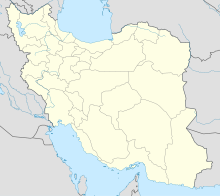Bishapur
Coordinates: 29 ° 46 ′ 40 ″ N , 51 ° 34 ′ 15 ″ E
Bishapur ( City of Shapur ) was a Sassanid royal seat. It is located in the province of Fars , 23 km (west) north of modern Kazerun ( Iran ) on a road from Persis to Elam , which in turn connected Istachr with Ctesiphon .
The place was already settled in Elamite and Parthian times, but was re-founded by Shapur I in 266, according to an inscription . According to the Hippodamian principle, the city was given a rectangular floor plan with a chessboard-like city map. It is believed that this goes back to Roman prisoners from the Battle of Edessa who were used in the construction of the city.
The remains of Bischapur today consist of three complexes. There is the actual city, there is a fortress and, not far to the east, in the side valley on the southern rock walls, there are six rock reliefs that celebrate Shapur I in particular, but also other rulers. Hans Henning von der Osten assumed that these reliefs in Hellenistic style embody Iranian content, which also point to captured Roman stonemasons. At some distance in the same valley further to the east, high above the valley in the northern mountain range, there is also a cave with an eight meter high statue of Shapur I. This was perhaps the ruler's grave monument.
The actual city has so far only been explored to a small extent. The ruins of the palace in particular still stand to a considerable height today. The center of the complex was a cross-shaped complex, which probably consisted of a courtyard and four ivans (reconstructed by the excavators as a domed hall, but this does not seem possible for structural reasons). It is the throne room of the palace, in the walls of which there were niches that once certainly contained statues of the ruler. The whole palace was decorated with mosaics that show stylistically (clearly) Hellenistic influence and were probably also designed and created by Roman prisoners.
The rock reliefs
- The first relief is dedicated to the investiture of Shapur I. The relief is not well preserved. It shows two riders facing each other. Ahuramazda presents the ruler with the ring of power.
- The second relief celebrates the victory of Shapur I over the Romans. The Roman emperor Philip Arabs kneels before the ruler. Gordian III. lies slain under the ruler's horse. Valerian , who was captured by the ruler, appears next to them and is held by Shapur I. The scene is flanked by senior Sassanid officials.
- A third relief also celebrates the victory of Shapur I over various enemies. Philip Arabs and Valerian are shown. Elephants appear, which suggests a victory over the Kushana .
- The fourth relief comes from Bahram I (273-276) and shows a delegation of Arabs .
- The fifth relief shows the investiture of Bahram I.
- The last relief comes from Shapur II (309–379) and shows the suppression of an uprising. The ruler is shown in the middle, sitting on a throne. Courtiers come to him, and finally prisoners.
See also
Web links
- Jonah Lendering: Bishapur . In: Livius.org (English)
- Bishapur . In: Ehsan Yarshater (Ed.): Encyclopædia Iranica (English, including references)


